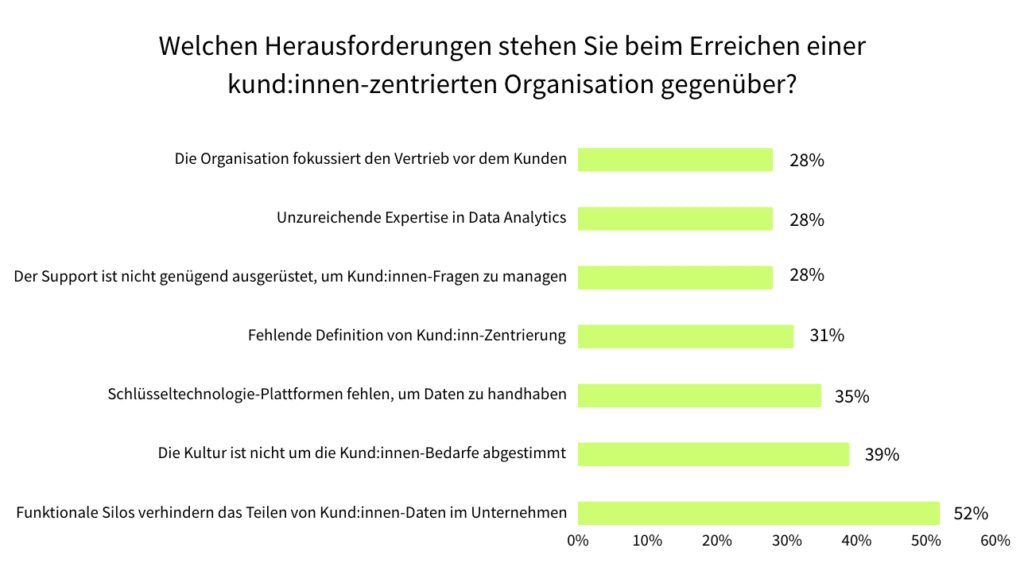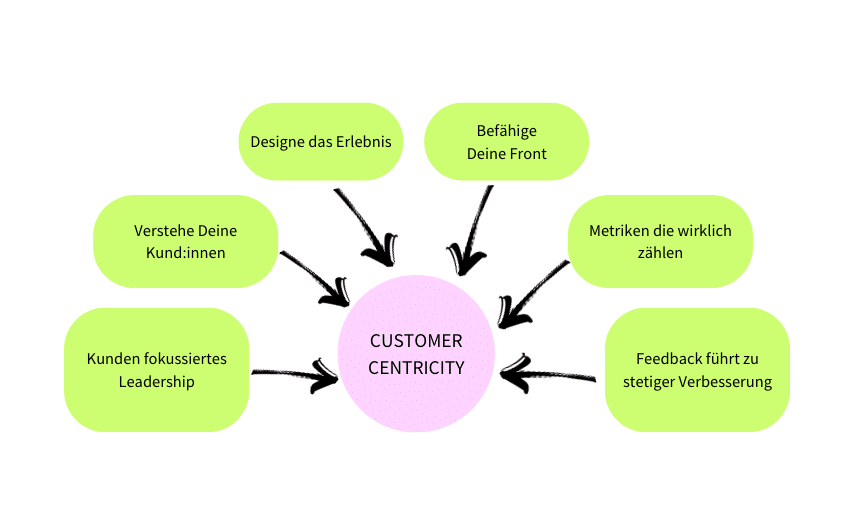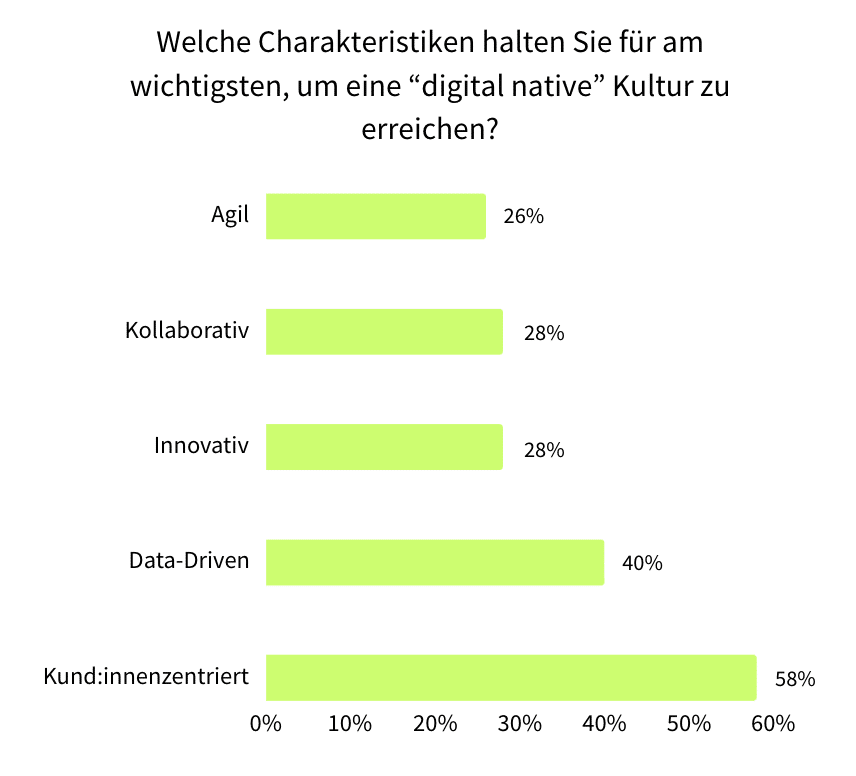Durch Customer Centricity die Digitalisierung als Chance begreifen
Aber was genau bedeutet eigentlich kundenzentriert (Customer centric) und was macht einen kundenzentrierten Ansatz aus? Auf das Wesentliche heruntergebrochen heißt es Folgendes: Agierst Du im Sinne der Customer Centricity, machst Du ein Geschäft mit Deinen Kund:innen, das sowohl vor, während als auch nach dem Kauf ein positives Erlebnis entstehen lässt. Im besten Fall wird die Kundin oder der Kunde zum/zur loyalen „Wiederholungstäter:in“ und kauft immer wieder bei Dir ein.
We see our customers as invited guests to a party, and we are the hosts. It’s our job every day to make every important aspect of the customer experience a little bit better.
Jeff Bezos Tweet
Amazon, aber auch andere große Digital-Spieler haben in den vergangenen Jahren viel Zeit damit verbracht, eine Kultur rund um den Kunden und seine Bedürfnisse aufzubauen. Das beginnt bei einem gezielten Marketing und endet bei personalisiertem After Sales Service. So entsteht ein Commitment zwischen Kunde bzw. Kundin und Unternehmen, das wahrhaftig ist. Es kann sogar so weit gehen, dass die Unternehmen sich mitunter lieber von einem Mitarbeiter als einem Kunden trennen.
Die Bedeutung von Customer Centricity wächst stetig – das liegt nicht zuletzt daran, dass mit der Digitalisierung besondere Chancen, aber auch Herausforderungen einhergehen. Beidem lässt sich durch einen kundenzentrierten Ansatz über mehrere Kanäle begegnen.
Customer Centricity - Ein Überblick
Customer Centricity: Warum überhaupt?
In einer Umfrage unter US-amerikanischen SME (kleinen und mittelständischen Unternehmen) durch Econsultancy wurden Charakteristika ausgewertet, die eine „Digital Native“ Unternehmenskultur ermöglichen.
Der mit Abstand am höchsten gewertete Charakterzug eines Unternehmens war mit 58 % die Kundenzentrierung.
Kein Wunder, oder?
Customer Centricity rückt das eigene Unternehmen in den Hintergrund und stellt die Wünsche und Bedürfnisse des Kunden bzw. der Kundin in den Fokus. Das bekundet Wertschätzung – eine solide Basis für gute und langdauernde Kundenbeziehungen, die wiederum den Unternehmenserfolg vorantreiben.
Die Bedeutung von Customer Centricity
Kundenzentrierung und Kundenorientierung als Unternehmensstrategie und unternehmenseigener Ansatz bedeutet nicht nur, großartigen Kundenservice zu bieten. Im Zentrum steht vor allem ein großartiges Erlebnis für den Kunden – von der Bewusstseinsphase über den Kauf bis hin zu Prozessen nach dem Kauf. Es ist eine Strategie, die darauf basiert, dass Deine Kund:innen an erster Stelle stehen.
Ansätze und Inspiration wie Du ein großartiges Erlebnis für deine Kunden bei all deinen Touchpoints der Customer Journey schaffst findest Du im Magazin-Artikel Customer Experience.
Wenn Du einen Kunden oder eine Kundin in den Mittelpunkt Deines Unternehmens stellst und eine Beziehung zu ihm/ihr durch Customer Relationship Management aufbaust, dann wirst Du im Laufe der Zeit eine große Anzahl an Daten sammeln. Diese Daten ermöglichen – richtig eingesetzt – einen Rundum-Blick auf Deine Kunden. Sie können dazu genutzt werden, um die Erlebnisse (die sog. Customer Experience) Deiner Kunden mit Deinem Unternehmen zu verbessern.
Warum switche ich oft zwischen deutsch und englisch? Ganz einfach erklärt. In der deutschen Sprache werden häufig in Bezug auf den “Kunden” englische Begriffe verwendet, die nicht 1:1 übersetzt werden können oder es gar keine passende deutsche Übersetzung gibt. Ein Beispiel gefällig? Customer Development ist ein Vorgehen aus Lean Startup und würde übersetzt “Kundenentwicklung” heißen. An sich ist eine wortwörtliche Übersetzung auch möglich, jedoch ist der Begriff Customer Development im Kontext zu Lean Startup viel weiter verbreitet als Kundenentwicklung.
So lassen sich solche Daten zum Verständnis von Kaufverhalten, Interessen und Engagement verwenden. Durch die Analyse der verschiedenen Kennzahlen kannst Du feststellen, welche zusätzlichen Produkte oder Dienstleistungen Dein Kunde möchte. Zudem kannst Du Kunden aufgrund ihres CLV, dem Customer Lifetime Value, segmentieren.
Der Erfolg eines solchen Vorgehens lässt sich sogar messen: Die Forschungsabteilungen global agierender Unternehmensberatungen sowie zahlreiche wissenschaftliche Untersuchungen haben gezeigt, dass kundenorientierte Unternehmen im Vergleich zu Unternehmen, die nicht auf den Kunden ausgerichtet waren, um bis zu 60 % profitabler sind.
Doch ein vollumfänglich auf Customer Centricity ausgerichteter Ansatz ist nicht per Knopfdruck erreich- und umsetzbar. Nach einem initialen Impuls ist es notwendig, eine durchdachte und kontinuierliche Strategie zu fahren, um das eigene Unternehmen langfristig und nachhaltig zu verändern. Dafür ist es notwendig, sich mit den Hintergründen der Customer Centricity auseinanderzusetzen.
Herausforderungen auf dem Weg zum kundenzentrierten Unternehmen
Der Machtwechsel zwischen Unternehmen und Kund:innen fand während der letzten wirtschaftlichen Krise statt. Kund:innen wurden wählerischer – sowohl bei Marken als auch bei Produkten und Unternehmen, für die sie ihr Geld ausgeben wollten. Die Gewinner dieser Entwicklung waren diejenigen, die ihre Kunden respektvoll und mit herausragenden Service behandelten und von Beginn an eine Beziehung zu ihnen aufbauten, die noch heute besteht.
Während dieser Zeit wurden diverse Kanäle und Marketing-Elemente wie Social-Media-Marketing und Social Selling ein wichtiger Teil der Customer Journey: Kunden können Produkte und Service nun in Echtzeit und über mehrere Geräte hinweg vergleichen. Das stellt(e) für viele Unternehmen, sowohl B2B als auch B2C, eine große Herausforderung dar. Die Notwendigkeit: Wer nicht mit dem Preis überzeugen kann, muss weiterführende und kundenzentrierte Services anbieten. Doch dies gelingt nicht jedem.
Mehr über die Customer Journey findest Du in diesem Artikel.
Customer Centricity is a culture of putting the customer at the center of everything you do.
Brian Solis Tweet
Untersuchungen haben gezeigt, dass Unternehmen mit diesem Wandel zu kämpfen haben und häufig nicht in der Lage sind, das eigene Geschäftsmodell hin zu einem kundenzentrierten Ansatz zu verändern. Vielen Unternehmen fällt es schwer, sich zu einer kundenzentrierten Organisation weiterzuentwickeln – wobei die größte Herausforderung darin besteht, Kundeninformationen nicht abteilungsübergreifend teilen zu können. Vielen Unternehmen fehlen relevante Komponenten, um kundenzentriert arbeiten zu können.
Noch bevor bestimmte Methoden und Wege zur Customer Centricity Anwendung finden, ist es relevant, dass Du Dir einer Sache bewusst wirst:
Customer Centricity bedeutet, bei und mit Deinen eigenen Kunden zu beginnen – nicht mit Deinen Produkten. Wenn Du Dein Unternehmen aus der Sicht des Kunden gestaltest, wird sich Dein Unternehmen auf die Bedürfnisse des Kunden konzentrieren. Schon alleine dies ist ein wichtiger Schritt in Richtung Customer Centricity.
Doch wie lässt sich Kundenzentrierung konkret umsetzen und worauf kommt es neben dem Mindset noch an?
Mit 4 Best Practices zum Kundenzentrierten Unternehmen
#1: Kundenverständnis erlangen
Unternehmen, die sich für Kundenorientierung engagieren, sind leidenschaftlich und glauben daran, dass der Kunde an erster Stelle steht. Sie glauben, dass Kunden maßgeblich am Erfolg des eigenen Business beteiligt sind (was wahr ist) und möchten die Welt durch die Augen des Kunden sehen. Marketingexperten in kundenzentrierten Organisationen wissen, was Kunden wünschen, und verwenden Kundendaten, um Kundeninformationen zu erfassen und diese im gesamten Unternehmen zu teilen.
Ich muss mich in jeder Situation in den Kunden hinein fühlen. Ich muss ständig verstehen wollen, wie Kunden denken, sprechen und handeln.
#2: Kundenzentriert handeln
Unternehmen, die sich für die Kundenorientierung engagieren, konzentrieren sich auf das, was der Kunde wünscht und braucht. Sie entwickeln Produkte und Dienstleistungen rund um den Kunden und seine Wünsche & Bedarfe.
Anzeige
#3: Kundenbeziehungen aufbauen
Unternehmen, die sich der Kundenorientierung verschrieben haben, konzentrieren sich auf den Aufbau von Beziehungen, die darauf ausgerichtet sind, die Produkt- und Serviceerfahrung der Kunden zu maximieren – mit jedem Touchpoint des Kunden mit dem Unternehmen.
#4: Kundenorientierung leben
Unternehmen, die Kundenorientierung leben, analysieren, planen und implementieren eine sorgfältig formulierte Kundenstrategie, die sich darauf konzentriert, profitable und loyale Kund:innen zu entwickeln und zu binden.
Wie genau die Methoden in Deinem Unternehmen aussehen können, um das Business auf den Kunden auszurichten, hängt von verschiedenen Faktoren ab. Sinnvoll ist es stets, sich mit der Gefühlswelt potenzieller Neu- und Bestandskunden vertraut zu machen. Das legt die Basis für umfassendes Kundenverständnis.
Ein bewährtes Tool dafür ist beispielsweise die Customer Empathy Map, die den Kunden, sein Umfeld sowie seine Beweggründe untersucht. So besteht die Möglichkeit, eigene Services und Produkte anzupassen und mögliche Touchpoints des Kunden mit dem eigenen Unternehmen angenehmer und personalisierter zu gestalten.
Wie misst man den Erfolg eines kundenorientierten Unternehmens?
Nicht jede Organisation hat die gleichen Metriken, um mit Tools des CRM (Customer Relationship Management) die Kundenorientierung zu messen. Die wichtigsten kundenzentrischen Metriken, die sorgfältig überwacht werden sollten, sind die Churn-Rate und der Customer-Lifetime-Wert sowie auch der Net Promoter Score. Mehr über sog. “Customer-Metriken” erfahrt ihr in unserer Wiki.
Dies gibt Deinem Unternehmen langfristig sowohl für Vertrieb, Marketing und Customer Success, aber eben auch für die Produktentwicklung die richtigen Insights.
Churn Rate
In vielen Branchen ist der Markt segmentiert. Die Gewinnung neuer Kund:innen wird zunehmend schwieriger. Daher investieren immer mehr Unternehmen in bestehende Kund:innen, anstatt in die Akquise neuer Kund:innen. Das liegt an folgenden Gründen:
Das Gewinnen neuer Kunden kann bis zu fünfmal mehr kosten als die Beibehaltung bestehender Kunden.
Eine 2%ige Steigerung der Kundenbindung hat den gleichen Effekt auf den Gewinn wie die Kostensenkung um 10 %. Im Durchschnitt verlieren Unternehmen ca. 10 % ihres Kundenstamms jedes Jahr (auch bekannt als Kundenabwanderung).
Unternehmen mit einer hohen Retention Rate (also der Beibehaltungs-Quote) wachsen schneller. Der Schlüssel zum Kunden-Erfolg liegt darin, zu verstehen, warum Kunden gehen und warum Kunden bleiben.
Um die Churn-Rate zu berechnen, misst Du die Anzahl der Kunden, die in den letzten 12 Monaten Dein Unternehmen verlassen haben, geteilt durch die durchschnittliche Anzahl der Kunden (im gleichen Zeitraum).
Customer Lifetime Value (CLV)
Für ein kundenorientiertes Unternehmen ist das wertvollste Kapital der Kunde. Gewinne, die während der Retention Phase generiert werden, werden oft als Customer Lifetime Value oder CLV bezeichnet. Customer Lifetime Value (CLV) misst den Profit, den Dein Unternehmen mit einem bestimmten Kunden erzielt.
Um den Lifetime Value (auch als LTV bezeichnet) zu berechnen, nimmst Du die Umsätze, die Du mit einem Kunden machst, ziehst davon alle Kosten ab, die Dir für die Pflege des Kunden anfallen, und passt anschließend alle Zahlungen für den zeitlichen Wert an. Ein anderer Weg, um den Lifetime Value zu berechnen, ist, den durchschnittlichen Bestellwert oder Rechnungswert zu nehmen und die Kaufraten zu wiederholen. Wenn Dein durchschnittlicher Bestellwert beispielsweise 100 € ist und die Wiederholungskaufrate pro Kunde 20 % beträgt, beträgt Dein geschätzter CLV 120 €.
Die Berechnung des Customer Lifetime Value hilft Dir, zu verstehen, warum es sinnvoll ist, in den Erhalt Deiner Kunden zu investieren. Dies bietet Dir und Deinem Unternehmen die Möglichkeit, Dein Kundenportfolio zu verstehen und Deine Kunden zu segmentieren.
Net Promoter Score
Natürlich sollte es nicht alleine bei diesen zwei Kennzahlen bleiben. Auch der Net Promoter Score (nps) ergänzend dazu ist eine wichtige KPI für Kundenzufriedenheit, um die Kundensicht auf Dein Unternehmen, Deine Lösungen, Produkte und Dienstleistung aus Sicht von Kunden-Personas anzureichern.
Dein Kunde kann Dir so mit Fokus auf das Kundenerlebnis seine Erfahrungen direkt zukommen lassen und Dir ergänzend seine Bedürfnisse schildern.
Zusammenfassung und Ausblick
Der Weg von einer produktorientierten hin zu einer kundenorientierten Organisation ist zum einen komplex und geschieht zum anderen nicht von heute auf morgen. Doch gerade alle aktuellen und anstehenden Möglichkeiten der Digitalisierung, Big Data und Einbeziehen von Kund:innen und Nutzer:innen über Social Media eröffnen Wege, die Kundenzentrierung zu meistern.
Hier gilt: Lass Dich nicht abschrecken. Selbst kleinste Änderungen an Euren Unternehmens-Prozessen können sowohl für die Mitarbeiter als auch für die Kunden von erheblichem Nutzen sein. Ob es sich hierbei um die reine Analyse der Touchpoints Deiner Kunden mit Deinem Unternehmen, handfeste Tools zum Customer Relationship Management oder eine konkrete Nachbesserung beim After Sales handelt – es gibt zahlreiche Möglichkeiten, den Herausforderungen der Digitalisierung durch kundenzentrierte Methoden zu begegnen.
Eine kundenzentrierte Organisation ist die Grundlage, um das wahre Potenzial des Kundennutzens zu erschließen. Aber versetzen sich Dein Unternehmen und Deine Mitarbeiter immer in die Rolle des Kunden und maximieren so den Kundenwert? Oder wo sehr ihr in der Praxis noch Optimierungsbedarf?

MD tractionwise | Behavioral Data & UX


